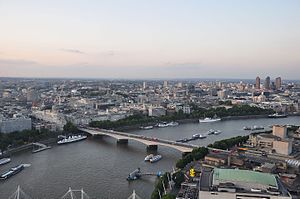Waterloo Bridge
| Waterloo Bridge | |
|---|---|

|
|
| Carries | A301 road |
| Crosses | River Thames |
| Locale | London |
| Named for | Battle of Waterloo |
| Heritage status | Grade II* listed structure |
| Preceded by | Hungerford Bridge and Golden Jubilee Bridges |
| Followed by | Blackfriars Bridge |
| Characteristics | |
| Design | Box girder bridge |
| Total length | 1,230 feet (370 m) |
| Width | 80 feet (24 m) |
| Longest span | 233 feet (71 m) |
| History | |
| Opened | 1945 |
Waterloo Bridge (/ˌwɔːtərˈluː/) is a road and foot traffic bridge crossing the River Thames in London, between Blackfriars Bridge and Hungerford Bridge. Its name commemorates the victory of the British, the Dutch and the Prussians at the Battle of Waterloo in 1815. Thanks to its location at a strategic bend in the river, the views from the bridge (of Westminster, the South Bank and the London Eye to the west, and of the City of London and Canary Wharf to the east) are widely held to be the finest from any spot in London at ground level.
The first bridge on the site was designed in 1809–10 by John Rennie for the Strand Bridge Company and opened in 1817 as a toll bridge. The granite bridge had nine arches, each of 120 feet (36.6 m) span, separated by double Doric stone columns, and was 2,456 feet (748.6 m) long, including approaches–1,240 feet (378.0 m) between abutments–and 42 feet (12.8 m) wide between the parapets. Before its opening it was known as the Strand Bridge.
During the 1840s the bridge gained a reputation as a popular place for suicide attempts. In 1841 the American daredevil Samuel Gilbert Scott was killed while performing an act in which he hung by a rope from a scaffold on the bridge. In 1844 Thomas Hood wrote the poem The Bridge of Sighs, which concerns the suicide of a prostitute there.
...
Wikipedia
